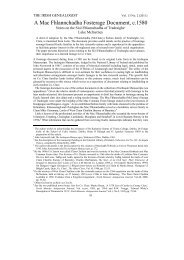Report Cover Vol I - Clare County Library
Report Cover Vol I - Clare County Library
Report Cover Vol I - Clare County Library
Create successful ePaper yourself
Turn your PDF publications into a flip-book with our unique Google optimized e-Paper software.
The <strong>County</strong> <strong>Clare</strong> Wetlands Survey Patrick Crushell & Peter Foss 2008<br />
_______________________________________________________________<br />
MESOTROPHIC – freshwater lake systems containing moderate concentrations of mineral nutrients,<br />
such as phosphorous, calcium and nitrogen. Having moderate levels of primary productivity or nutrients<br />
(intermediate between oligotrophic and eutrophic).<br />
MICROTOPOGRAPHY - Very small-scale variations in the height and roughness of the ground surface.<br />
MINEROTROPHIC MIRE - A peatland system that is fed by ground water.<br />
MIRE - A general term applied to peat producing ecosystems. cf. bog, peatland.<br />
MONITORING – A repeat or repeats of a survey using the same methodology. Designed to look for or<br />
measure specific changes and the rate or extent of change. Used to check the “health” quantity or quality<br />
of a habitat or species.<br />
MONTANE - Of or relating to mountains.<br />
MOOR - Shallow acid peatland less than 40 cm peat depth, often resting on iron pan and podzol; and<br />
dominated by ericaceous vegetation.<br />
MOR HUMUS - Organic soil that is acid and comprises layers of plant litter.<br />
MORAINE - Ridge or mound of unsorted mineral material deposited by glaciers.<br />
MOSAIC - Used to describe habitats that occur together and cannot easily be mapped separately.<br />
Complex pattern or patchwork of habitats or species occurring in intimate associations.<br />
MUD - Silt/clay fraction where sediment particles are less than 0.063 mm in diameter.<br />
MULTIPLE PRIVATE OWNERSHIP- Lands that are divided into areas which are privately owned. There<br />
must be more than one private landowner under this heading. (lands in commonage are not described<br />
under this heading).<br />
NATIONAL PARKS AND WILDLIFE SERVICE (NPWS) – the section of the Environment Infrastructure<br />
and Services division of the Department of Environment, Heritage and Local Government with<br />
responsibility for nature conservation and implementation of Government conservation policy as<br />
enunciated by the Minister for the Environment, Heritage and Local Government.<br />
NATURA 2000 - A network of sites across the European Community, selected for the purpose of<br />
conserving natural habitats and species of plants and animals which are rare, endangered or vulnerable<br />
in the European Community. SACs and SPAs form the Natura 2000 network.<br />
NATURAL HABITAT - Can be aquatic or terrestrial areas distinguished by geographic, abiotic and biotic<br />
features, whether entirely natural or semi-natural.<br />
NATURAL HERITAGE AREA (see also NHA types below) - The basic designation for wildlife<br />
conservation is the Natural Heritage Area (NHA). This is an area considered important for the habitats<br />
present or which holds species of plants and animals whose habitat needs protection. Some of these sites<br />
are small, such as roosting areas for rare bats; others can be large such as a blanket bog or a sand dune<br />
system. To date, 75 raised bogs have been given legal protection, covering some 23,000 hectares. A<br />
further 73 blanket bogs, covering 37,000ha are also designated as NHAs. Under the Wildlife Amendment<br />
Act (2000), NHAs are legally protected from damage from the date they are formally proposed for<br />
designation.<br />
pNHA - Proposed Natural Heritage Areas which were published on a non-statutory basis in 1995, but<br />
have not since been statutorily proposed or designated. These sites are of significance for wildlife and<br />
habitats. Some of the pNHAs are tiny, such as a roosting place for rare bats. Others are large - a<br />
woodland or a lake, for example. The pNHAs cover approximately 65,000ha and designation will proceed<br />
on a phased basis over the coming years.<br />
Prior to statutory designation, pNHAs are subject to limited protection, in the form of:<br />
Rural Environment Protection Scheme (REPS) plans which require conservation of pNHAs and<br />
operate for a period of 5 years<br />
Forest Service requirement for NPWS approval before they will pay afforestation grants on pNHA<br />
lands<br />
123
















